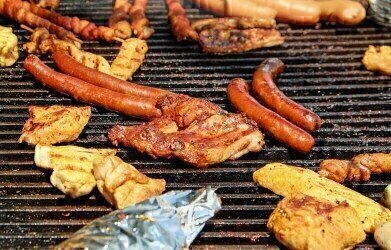Environmental Laboratory
Is Your BBQ Damaging the Environment?
Jul 24 2019
The average summer barbecue, with enough food to feed four people, releases more greenhouse gases (GHGs) into the atmosphere than that incurred by a journey of 80 miles in a car, says a new study from the UK. By analysing GHG emissions at every stage of the process, including production, processing, supply and consumption, the team demonstrated that a typical barbecue would release around 200 balloons filled with carbon dioxide (CO2) per person in attendance.
The astonishing findings were showcased at this month’s Royal Society Summer Science Exhibition, which took place from the 1st to the 7th of July. In an exhibit named “Take a Bite out of Climate Change”, the researchers used helium balloons to provide a visual illustration of just how damaging our barbecues can be for the environment. However, their study comprises constructive criticism as well; they also offer practical suggestions for how the risks can be curbed.
Ballooning emissions
Carbon emissions are present all throughout the food industry, from the carbon dosing which takes place in commercial greenhouses to the vehicle emissions needed to transport produce to stores, supermarkets and restaurants to the barbecues which cook it. Indeed, the food sector is responsible for contributing more than 20% of all GHG emissions, according to Professor Sarah Bridle, lead author on the study. As such, Bridle and her colleagues wish to provoke a sea change in our attitudes towards barbecuing this summer.
After measuring carbon emissions at each step of a foodstuff’s life cycle and assimilating all this information into a single total, the team communicated it via how many balloons the carbon would fill to give consumers a tangible idea of their footprint. It turns out that it takes enough carbon to fill 60 balloons just to produce and cook a single standard beef burger, while every bottle of beer consumed translates into eight balloons and every portion of strawberries and cream equates to 10 balloons (or 20 balloons if imported when out of season locally).
Changing habits for the better
Clearly, the impact of a simple Sunday barbecue might be farther reaching than we think. In certain regions of the world, they have taken drastic measures to counteract these damaging emissions; China outlawed open-air barbecues as far back as 2013, for example. However, Bridle and her team are not suggesting anything quite so extreme, but rather a subtler adjustment in our habits which could have a colossal cumulative impact on GHG emissions.
Simply swapping out beef burgers for chicken ones brought the number of balloons down from 60 to 45 per patty and the overall total of balloons for the meal down from 200 balloons to 130 balloons per person. Meanwhile, a vegan affair, where meat substitute was used instead of burgers, onion instead of cheese, vegetable spread instead of butter and sugar instead of cream, reduced the total for the meal to a mere 80 balloons per person. While that is still a relatively high amount, it’s less than half what is being emitted at present and the authors hope their work will provide some food for thought for enthusiastic BBQers this summer.
Digital Edition
AET 28.3 September 2024
September 2024
Business News - ENVEA announces acquisition of APAQ Group - SICK and Endress+Hauser sign strategic partnership - Efforts to curb gas flaring intensify amid environmental concerns Air Monito...
View all digital editions
Events
Sep 21 2024 Tianjin, China
Meteorological Technology World Expo 2024
Sep 24 2024 Vienna, Austria
Water Africa and East Africa Building & Construction
Sep 24 2024 Kigali, Rwanda
Elmia Water and Wastewater Fair - POSTPONED
Sep 24 2024 Jonkoping, Sweden
Sep 25 2024 Vientiane, Laos




.jpg)














